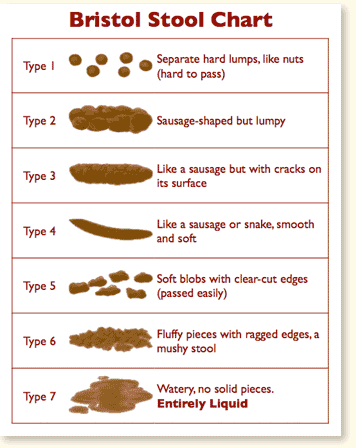The Scoop on Poop
Why We Poop
A bowel movement is simply what the body excretes after it has taken out all the nutrients it needs from the food we eat. In goes food, out goes waste. Our bodies needs to excrete this waste daily, otherwise toxins in the waste matter build and enter the bloodstream, causing harm to the body (also known as autointoxication). Frequent bowel movements are an important part of good health, and are nature's way of getting rid of the garbage.
What’s Your Poo Telling You? Richman & Sheth |
Changes in the color, consistency, and frequency of your bowel movements are completely normal from time to time. Your diet and level of stress will immediately affect your digestion, and affect what comes out (or gets stuck at!) the other end.
But what is the ideal poop? Should it be hard or soft? Long or short? What about color? How often should you be pooping, and what if it is gassy? You can learn a lot about the health and condition of your body by sneaking a peak at your poop before you flush. All you need to do is simply observe it!
 Learn more about why we need gut bacteria for perfect poops:
Learn more about why we need gut bacteria for perfect poops:
The Body Healer Protocol...
Ok, let's get nitty gritty! Are you a pooper trooper, or do your poops need a bit of help? Let's take a look at the ideal poop. We will look at poop color, shape, size, odor, and frequency. We will also talk about whether it floats or sinks, and if it contains things that it shouldn't. Then, we will top it off with what you can do for some smooth moves!
So, what's the ideal poop?
An alkaline diet full of whole, fresh, raw fruits and veggies is one of the best ways to achieve the perfect poop. Not only are they power-packed with nutrition, but they are also naturally high in fiber and assist in daily detoxification. The best quality fiber (both soluble and insoluble) comes from whole foods such as pears, apples, leafy greens, ground chia and flax seeds, lentils, and beans. Leafy greens also help stimulate bile flow.
| Are You A Pooper Trooper? The Ideal Poop | Imperfect Poops | |
| Are banana-shaped. | Are not properly formed. | |
| Are brown in color. | Are black, clay, yellow, or green (may be due to certain foods or supplements - see below). | |
| Do not stick to the toilet. | Have mucus/are greasy, stick to the toilet. | |
| Have very little odor. | Have a very strong odor. | |
| Are easy to wipe with no mess. | Contain undigested food, require multiple wipings. | |
| Come at least once, preferably 2-3 times a day. | Are less than once a day. | |
| Are formed but semi-soft. | Are either too loose or too hard. | |
Poop Characteristics
Poop Color
Generally, stool is walnut brown in color because of the bile produced by the liver. Changes in color are usually temporary and can happen if you eat certain foods or drink certain juices (such as beet juice or carrot juice, which contains pigments that cause red and orange poops). These temporary changes are no cause for concern. A drastic and longer lasting color change is something to pay attention to.
In a healthy digestive system, the stools pass from the small intestine to the colon and change color along the way. They go from green, to yellow, to brown. The shorter the digestive time, the more greener the stool.
Let's take a look at the different colors of poop and what these colors may indicate:
Poop Shape & Size
The size of poop varies depending on what has been eaten and in what quantity. People who eat plenty of fiber have larger stools. Fiber is indigestible, which means that any amount of fiber not fermented in the gut will pass through whole or be fermented by intestinal flora. Stool should be the length of a banana (6-10 inches in length) and look similar to a torpedo.
Researchers at the Bristol Royal Infirmary in England developed a visual guide for stools called the Bristol Stool Form Scale to help us distinguish normal stools from abnormal stools:
 #1 Rabbit Poop
#1 Rabbit Poop
Many people produce small, hard, pellet-like poops similar to rabbit poop. Sometimes, the lumps are quite hard and abrasive, causing pain and bleeding when they exit. These are often seen in people who have a low fiber diet from eating too many white foods lacking fibrous content (white rice, white bread, white pasta, and sugar) and low carb diets from eating primarily protein foods with no fiber. Dehydration can also cause rabbit poop.
Eating more fiber-rich foods, cutting out refined foods, and ensuring you are well-hydrated is the best remedy.
#2 Nutty Log
Similar to Type 1, but the pieces are lumped together with some fiber and bacteria. Because of how firm the pieces are, they can be painful to eliminate and cause bleeding, anal canal laceration, or diverticulosis. These stools may have been in the colon for at least several weeks, instead of the normal 72 hours.
People with such stools are more likely to suffer from IBS because of the continuous pressure of large stools on the intestinal walls. The possibility of intestinal obstruction is high, because the large intestine is filled to capacity with stools. Adding supplemental fiber to expel these stools is dangerous, because the expanded fiber has no place to go, and may cause hernia, obstruction, or perforation of the small and large intestine.
#3 Smoother Nutty Log
Similar to type 2, but the transit time is quicker - up to 1 week. IBS is likely, as is constipation. Straining to poop is typical.
#4 Banana Roll
A 6-10 inch banana length stool which is smooth and soft is considered normal.
#5 Smooth, Soft & Chunky
This is considered the ideal, and is typical for someone who has stools 2-3 times a day.
#6 Lumpy Mush / Loose Stools
With this poop, it may sometimes be difficult to control the urge, a problem if a bathroom is not nearby. It is considered borderline normal and can suggest a hyperactive colon, too much potassium, sudden rehydration, drinking high mineral content water, or a rise in blood pressure related to stress. It can also indicate someone with a hypersensitive personality prone to stress,
Other common causes of loose stools include use of colon-cleansing supplements, laxatives, stimulants such as coffee, high doses of vitamin C, magnesium, antibiotics, chemotherapy... the list goes on.
#7 Diarrhea
Here, the poop is in either very loose or in liquid form. Sometimes, it only occurs once or twice a day, and at other times can be acute and require frequent (and speedy!) bathroom trips.
Poop Odor
Our intestines are swarming with trillions of friendly bacteria that help us to digest and metabolize our food. This is also the reason why poop smells - a result of the bacterial activity in your GI tract. It is normal for your bowel movements to have some odor, but despite what you may hear, rotten or foul smelling poop or gas that clears the family out of the room is not a sign of good poop health! If fecal matter has a sharp, sour, or penetrative odor, this indicates that food is not being digested properly.
Generally speaking, those who have a diet high in processed and refined foods, and those who are heavy meat-eaters, have very stinky poop. This points to an acidic body, indicating there is likely putrefying proteins and fermenting carbohydrates rotting in the intestines. Stress can also contribute to an acidic body.
- The acid/alkaline balance & your health
- How we become overly-acidic
- Stress & how much it damages the body
- 14 tips to help you eliminate stress right now
Poop Frequency
At minimum, you should have one good bowel movement per day, but 2-3 is considered ideal for optimal health.
Stuff In the Stool
Poop Flotation
Normal, healthy stools should be pooped easily and effortlessly, gently submerging into the water. If your diet is low in fiber (less than 30-40 g/day), the stool will plummet quickly to the bottom of the toilet. Floating stools indicate a large amount of undigested fats, which are lighter than water. Floating poop can indicate either too much fat in the diet, or a problem digesting fats.
BEFORE YOU GET POOP PARANOID!
Diet and stress dramatically affect our poop. By simply cleaning up your diet and reducing your stress level, in most cases you will automatically clean up your poop. Eating a diet rich in healthy foods such as fruits and vegetables (especially the leafy greens) ensures you will have the appropriate amount of fiber in your diet. The caveat is if you see any fresh or black blood in your stool. Then it is time for a trip to the doctor.
A Note About Fiber
Irini |
Many people rush to the store and take fiber supplements en-masse to either firm up stools or stimulate a bowel movement. Unless you have been traveling, or have eaten foods that are the likely culprits, then these temporary measures are band-aids at best that only serve to artificially stimulate a bowel movement. They do not address the problem that caused the loose stools, or constipation, in the first place.
Contrary to popular belief, excessive supplemental fiber can cause hemorrhoids, diverticulosis, IBS, and colon cancer. Nature provides all the fiber you need if you eat the right foods.
One of the best and healthiest ways to stimulate a bowel movement every morning is to make your own veggie juice with fresh veggies, or a fruit and veggie smoothie. The only thing you will need to invest in is a juicer and/or blender, and there are so many good quality ones on the market at very reasonable prices.
Make Your Own Healthy V8 or F5 Juice
There are so many different and flavorful ingredients that you can use to make raw fruit and veggie drinks, but these two are the most exciting and refreshing home-made combos our family uses every day!
| Home-made V8 Juice | The Fruity Rini Smoothie | |
 I often add a Granny Smith apple to the mix, which helps give a nice, crisp tang! |

|
RELATED ARTICLES
- Your immune system & how it works
- The SAD (S)tandard (A)merican (D)iet
- Why our pets are getting sicker
- Raising children naturally



